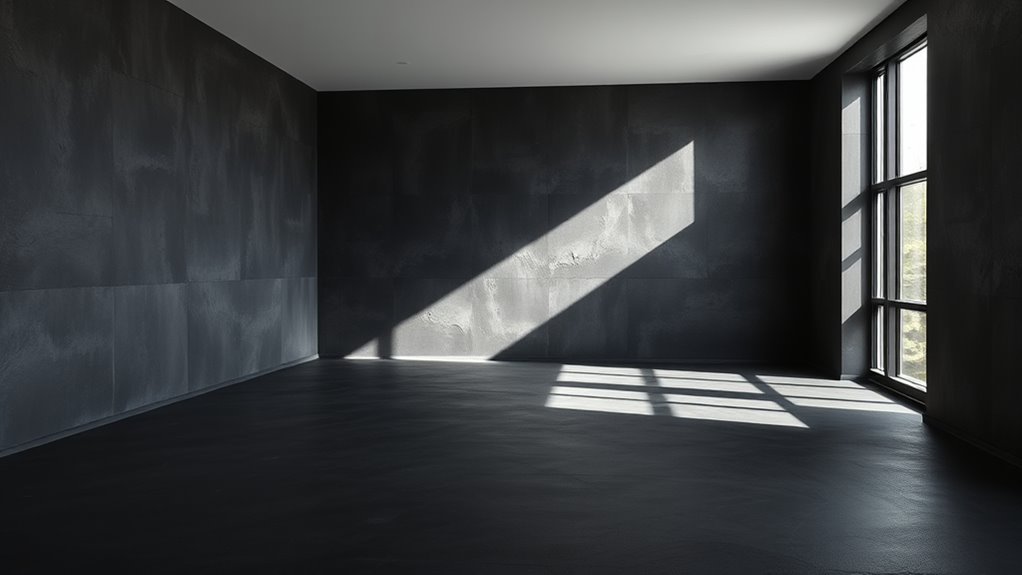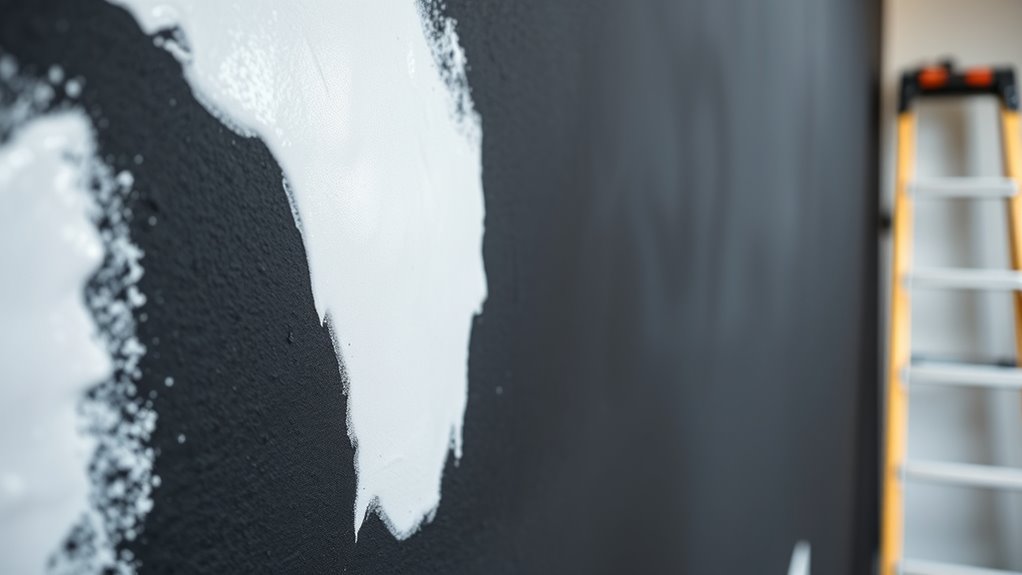To cover dark walls with light paint effectively, start with high-quality paints in soft whites, beiges, or pastels that reflect light well. Use finishes like satin or eggshell to add brightness and a sleek look. Test shades on your walls before committing, considering natural and artificial light. Incorporate light-colored trims and accessories to boost the space’s openness. If you keep exploring, you’ll discover more tips to achieve a bright, inviting room.
Key Takeaways
- Test light paint swatches on dark walls under different lighting to ensure desired brightness and color accuracy.
- Use high-contrast shades like whites or pastels to effectively brighten and open up the space.
- Choose satin or eggshell finishes to reflect more light and enhance room brightness.
- Incorporate light-colored trim and decor to complement the new light walls and maximize visual impact.
- Prepare dark walls properly by cleaning and priming to ensure smooth, even coverage of light paint.

Have dark walls ever made your space feel cramped or gloomy? If so, you’re not alone. Dark walls can create a cozy atmosphere, but they often make rooms seem smaller and less inviting. Luckily, choosing the right light paint can transform your space, making it feel brighter, larger, and more open. The key begins with understanding how color contrast and paint selection play essential roles in this process.
When you’re selecting paint, focus on creating a high contrast between your walls and the light colors you want to introduce. Light shades such as soft whites, creamy beiges, or pastel tones reflect more natural and artificial light, instantly brightening the room. The contrast between your dark walls and these lighter shades will help open up the space, making it feel less confined. Think of it as a visual reset—your dark walls act as a backdrop, and the light paint draws the eye inward, giving the illusion of more space.
Choosing the right paint isn’t just about picking a light color; it’s about selecting the best type for your needs. Flat or matte finishes absorb light, which can make a room feel softer and more subdued, but they may also highlight imperfections. Satin or eggshell finishes reflect more light, adding a subtle sheen that enhances brightness and makes your walls look fresh and clean. If you want to maximize light reflection and create a more airy atmosphere, opt for these finishes. Furthermore, quality paint matters; better coverage means fewer coats, fewer drips, and a smoother finish that looks professional.
Before you buy, test a few shades on your wall. Dark walls can sometimes influence how a light color appears, making it look different than it does in the store. Paint swatches directly on your wall and observe how they look at different times of day, under natural and artificial light. This step ensures you pick a shade that truly brightens your space without losing warmth or personality. Additionally, understanding the importance of AI safety measures can be useful when seeking guidance on selecting the right paint and finishes, as technology can assist in visualizing color choices before application.
Incorporate color contrast thoughtfully by using accents and furnishings that complement your new light walls. Bright white trim, light-colored furniture, and strategic accessories will amplify the effect of your light paint choices. Remember, the goal is to create a balanced, inviting atmosphere where your dark walls no longer dominate the room but instead serve as a stylish contrast to your lighter decor. With careful paint selection and an eye for color contrast, you’ll transform your gloomy space into a bright, welcoming haven.
Frequently Asked Questions
How Long Does Light Paint Coverage Last on Dark Walls?
Your light paint coverage on dark walls usually lasts 5 to 10 years, depending on quality and application. Good paint durability guarantees the color stays vibrant longer, but over time, you might notice some fading. Proper prep and using high-quality paint can extend this lifespan. Remember, environmental factors like sunlight and humidity can accelerate color fading, so take care of your walls to keep their bright appearance for as long as possible.
What Are the Environmental Impacts of Using Light-Colored Paints?
Imagine bright, airy spaces filled with eco-friendly formulas that brighten your home without harming the planet. Using light-colored paints reduces VOC emissions, making your environment safer and healthier. These paints minimize air pollution and lessen environmental impact, unlike traditional options. By choosing eco-friendly options, you help protect ecosystems while enjoying a fresh, vibrant look. Your choices matter—opt for paints that are good for the planet and your indoor air quality.
Can Light Paint Be Applied Over Textured Dark Walls?
Yes, you can apply light paint over textured dark walls. To achieve a smooth finish, you may need to prime the wall first for better color matching and to hide the dark base. Consider the texture enhancement by choosing a paint type that complements the wall’s texture, like a thicker or semi-gloss finish. Proper surface preparation guarantees even coverage and a vibrant, long-lasting light-colored appearance.
Are There Specific Primers Recommended for Dark Walls?
Yes, you should choose a primer compatible with your wall surface. For dark walls, stain-blocking primers are highly recommended because they prevent underlying colors from bleeding through your light paint. Look for primers labeled for dark or stained surfaces to ensure proper coverage and adhesion. Using the right primer helps create a even base, making your light paint job look fresh and vibrant while guaranteeing long-lasting results.
How Does Lighting Influence the Appearance of Light-Painted Walls?
Lighting transforms your space like a master artist’s brush, influencing how light paint appears on your walls. Bright, natural light amplifies the wall color contrast, making your walls feel more open and airy. Conversely, warm or dim lighting softens the contrast, creating a cozy ambiance. Consider your lighting effects carefully, as they can enhance or diminish the impact of your light-painted walls, shaping the mood and perception of your room.
Conclusion
Now that you know how to cover dark walls with light paint, you’re well on your way to brightening up any room. Just remember, patience is key—sometimes it takes more than one coat to get it just right. Don’t rush the process or you might end up chasing your tail. With a little effort and the right technique, your walls will shine like a beacon, transforming your space into a fresh, inviting haven.









